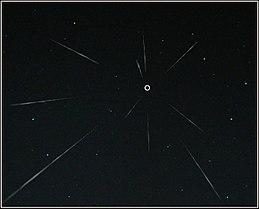
Back Uitstralingspunt Afrikaans Радыянт Byelorussian Радыянт BE-X-OLD Радиант Bulgarian দীপ্তিমান উল্কা (উল্কা ঝরনা) Bengali/Bangla Radiant (astronomia) Catalan Radiant Czech Radiant (Astronomie) German Ακτινοβόλο σημείο Greek Radiante Spanish

The radiant or apparent radiant of a meteor shower is the celestial point in the sky from which (from the point of view of a terrestrial observer) the paths of meteors appear to originate.[1] The Perseids, for example, are meteors which appear to come from a point within the constellation of Perseus.
Meteor paths appear at random locations in the sky, but the apparent paths of two or more meteors from the same shower will diverge from the radiant. The radiant is the vanishing point of the meteor paths, which are parallel lines in three-dimensional space, as seen from the perspective of the observer, who views a two-dimensional projection against the sky. The geometric effect is identical to crepuscular rays, where parallel sunbeams appear to diverge.
A meteor that does not point back to the known radiant for a given shower is known as a sporadic and is not considered part of that shower.
Shower meteors may appear a short time before the radiant has risen in the observer's eastern sky. The radiant in such cases is above the horizon at the meteor's altitude.
During the active period of most showers, the radiant moves nearly one degree eastwards, parallel to the ecliptic, against the stellar background each day. This is called the radiant's diurnal drift, and is to a large degree due to the Earth's own orbital motion around the Sun, which also proceeds at nearly one degree a day. As the radiant is determined by the superposition of the motions of Earth and meteoroid, the changing orbital direction of the Earth towards the east causes the radiant to move to the east as well.